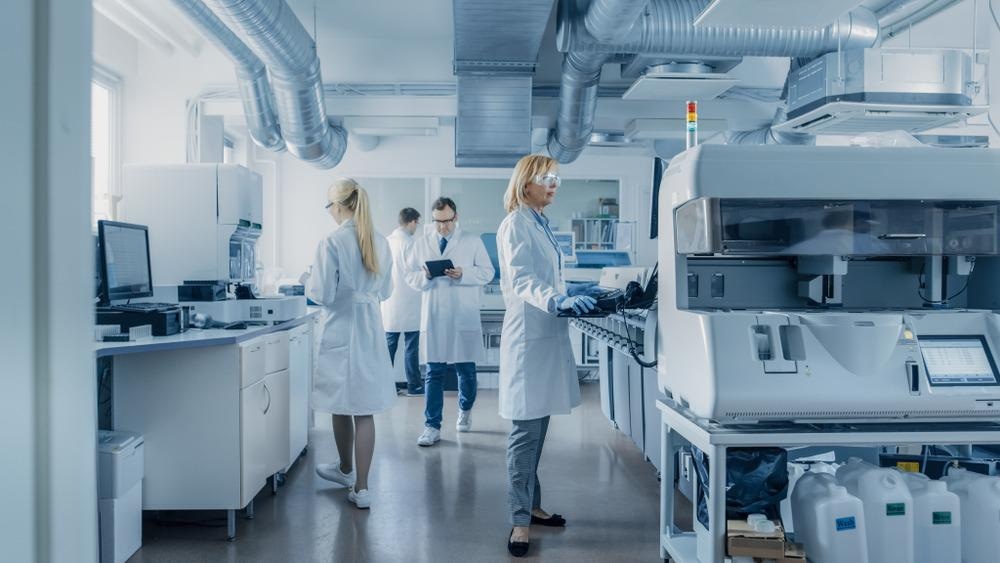A team of researchers has reported the use of synthetic hydrogels to facilitate the growth of lymphatics for the purposes of regenerative medicine and a deeper understanding of lymphatic vasculature. Their study is currently in the pre-proof stage in the journal Biomaterials.

Study: Synthetic hydrogels engineered to promote collecting lymphatic vessel sprouting. Image Credit: Gorodenkoff/Shutterstock.com
The Lymphatic System
Liquid is transported through the lymphatic system between the cardiovascular system and the interstitial tissue space. Once it enters the lymphatic system, this liquid is termed lymph. By transporting liquid around the body, the lymphatic system maintains fluid homeostasis. The lymphatic system can transport up to 8 liters per day. Aside from maintaining fluid homeostasis, the lymphatic system plays a key role in the body’s immune response by transporting immune cells to lymph nodes.
Lymphangiogenesis
The process where lymphatic endothelial cells proliferate and form new vessels is termed lymphangiogenesis. The prevailing view currently is that post-natal lymphangiogenesis is initiated from lymphatic vasculature, such as lymphatic collecting vessels. Lymphatic collecting vessels contain a layer of lymphatic endothelial cells surrounded by lymphatic muscle cells. Mature collecting vessels differ structurally from initial lymphatics.
Structurally, initial lymphatic capillaries consist of loosely connected lymphatic endothelial cells with specialized junctions, anchoring filaments, and no basement membrane. Lymphatic muscle cells, which surround mature lymphatic endothelial cells, contain contractile elements which are vital for the phasic contraction of lymphatics to generate lymph.
Research has thrown light on the complex signaling environment that is key to recruiting and orienting lymphatic muscle cells in mature lymphatic vasculature cells during prenatal development. Lymphangiogenesis has many parallels with angiogenesis, including being regulated by the same growth factors and signaling pathways. This process is induced during inflammation and wound healing in healthy individuals. However, lymphangiogenesis can be associated with certain pathological disorders.
Lymphedema, for instance, is a pathological condition that can be caused by some cancer treatments. This is a chronic condition where soft tissue swelling or fibrotic remodeling occurs due to the obstruction or dysfunction of lymphatic vessels. This incurable condition severely impacts the patient’s quality of life. 15-30% of breast cancer patients are estimated to suffer from lymphedema in developed countries.
More from AZoM: What is Femtosecond Laser-Based 3D Printing?
Several treatments have been explored for lymphedema, with lymph node flap and vascularized lymph node transfer methods demonstrating positive results for reducing swelling. Whilst not fully understood, this process may involve localized lymphangiogenesis. There exists the possibility for transfer-free neo-lymphangiogenesis.
The Study
Biomaterial platforms that can augment lymphangiogenesis and aid the growth of lymphatics represent a significant research opportunity in biomedical sciences. In the study, the authors have engineered a 3D synthetic hydrogel system for this purpose. A comprehensive literature review was performed by the authors.
Various parameters were optimized to produce the novel hydrogel platform in the research, and were used to support cultivated lymphatic collecting vessel segments from rats. The hydrogels consisted of a four-armed PEG macromer. Maleimide groups at each terminus were conjugated to crosslinking peptides and cell adhesive ligands. By tuning the weight percentage of PEG or the type and density of the crosslinking and adhesive types caused significant changes in tissue phenotype.
The authors have highlighted that recent research has demonstrated the feasibility of using synthetic materials such as hydrogels to support three-dimensional lymphangiogenesis, usually with including support cells and progenitor cells. However, there is a lack of knowledge on how these platforms can be engineered to support lymphatics sprouting and the coordinated development of lymphatic endothelial and lymphatic muscle cells from lymphatic collector vessels.
In the research, the authors have sought to leverage the properties of the novel PEG hydrogels to engineer lymphatic collector vessels. The effects of degradability, type of adhesive peptide and density, and the hydrogel’s stiffness on network formation were investigated by the authors. By determining the optimal formulation, the utility of the novel hydrogel for supporting localized lymphatic collecting vessels following injury was demonstrated in the research.
The novel PEG hydrogel developed by the researchers is consistent and tunable. Several understudied lymphatic sprouting regulators were revealed using this hydrogel, along with unique sprouting phenotypes. The role of different adhesive peptides was revealed and studied in depth in the paper. The research set out in the paper is highly promising, and the authors have identified several challenges and future opportunities for the use of these synthetic PEG hydrogels to aid lymphangiogenesis.
The authors have stated that incorporating different adhesive peptides into the PEG hydrogels in future studies could reveal novel, synergistic effects on lymphangiogenesis, and could have important implications for the treatment of lymphedema in cancer patients. Additionally, the use of the hydrogels as scaffolds can support lymphatic tissue regeneration and help prevent issues arising following lymph node resection.
Further Reading
Hooks, J.S.T et al. (2022) Synthetic hydrogels engineered to promote collecting lymphatic vessel sprouting [online, pre-proof] Biomaterials 121483 | sciencedirect.com. Available at: https://www.sciencedirect.com/science/article/abs/pii/S0142961222001223
Disclaimer: The views expressed here are those of the author expressed in their private capacity and do not necessarily represent the views of AZoM.com Limited T/A AZoNetwork the owner and operator of this website. This disclaimer forms part of the Terms and conditions of use of this website.